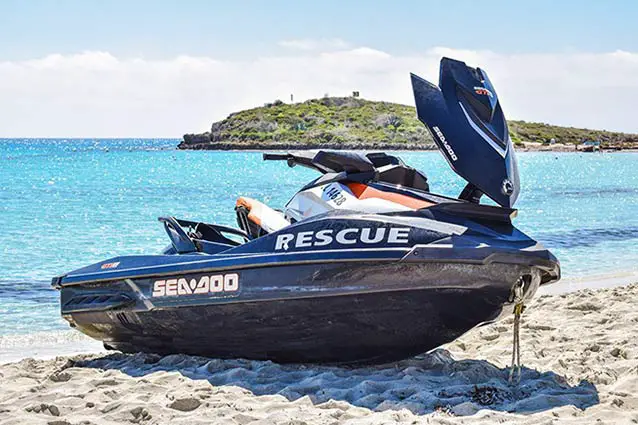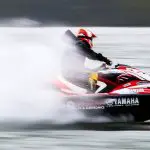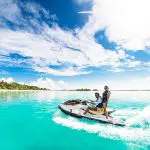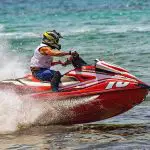The best thing about modern Jet Ski is that they are so stable and user-friendly that anyone can ride one.
Personal responsibility is paramount for new and experienced riders alike.
Stay Safe!
Contents
A brief anecdotal analogy
In the mid-1970s, Honda introduced its ATC three-wheeler line. It was a huge hit with an adoring public – many of whom had never imagined riding a motorcycle.
Other manufacturers followed suit, and suddenly the sand dunes and river banks of America were filled with new enthusiasts.
These new machines, after all, stood up by themselves! Most featured an automatic clutch, so no skill was needed to shift rapidly through the gears. Thousands and thousands were sold, a huge sales bump for dealerships all across the country.
And then reality reared its head. Because anyone could get on a three-wheeler and go, first time riders who had no experience whatsoever too often found out what a motorcycle teaches a new operator on the first day – don’t override your skills.
The “stability” of these three-wheelers was a bit of an illusion, as sudden turns would send riders tumbling. The ease of achieving relatively high speeds often ended in broken bones and worse as solid objects – like a big tree, for instance – would almost inevitably jump out in the way of inexperienced operators.
A bit of a nanny state soon developed as these injuries accumulated, and the federal government actually stepped in to heavily regulate the sales of ATVs.
Manufacturers responded by dropping the three-wheeled design and moving on to four wheels. More stability! Yay! Easier still to ride for newbies! Yay!
Um… yeah. Not really.
The argument for building skills.
By the time the nineties rolled around, four-wheeled ATVs remained very popular but were delivered with myriad warning labels, cautioning against most activities that might be considered fun. Sound familiar?
The government’s ATV consent decree required that no ATVs whatsoever be sold for operation by anyone under 12 years of age, and that size was limited to 90cc machines for ages 12-16. Salespeople were required to ask “who is this ATV meant for?” And if the answer wasn’t the appropriate one, the conversation was over. Dealers faced heavy fines and even loss of their franchise for any violations.
I was heavily immersed in all things motorcycle and personal watercraft at the time, and was certainly of the opinion that an ATV could be very useful for important matters such as backing a jet ski trailer into the ocean. But to ride one in a sporting way?
I was often asked by parents about what ATV they should purchase for their child. “None” was my answer. “Get a motorcycle.”
This may seem counter-intuitive to some. But I still maintain that a motorcycle, like a bicycle before it, requires a rider to develop balance and coordination in order to ride, and certainly to ride at any speed.
“Yes,” I would explain. “Your kid will crash his dirt bike. Likely many times. But those crashes will occur at low speeds and will be most useful in helping the kid learn the consequences of riding faster than their skills allow. And then they’ll slow down, and learn to ride. They’ll have to.”
“Get him one of those ATVs and he’ll probably run right into the side of the house at high speed on day one.”
Without the proper supervision, instruction, and forbearance, casual permission for a new rider to hop atop a 200-horsepower 1800cc personal watercraft can likewise end in tears – or when someone hits a dock at high speed.
Or even worse, another boater.
Crashes man. I’ve seen it.
I’ve searched my memory in preparing to write this article, and I cannot remember a single instance where I saw someone who had cut their teeth riding stand-up skis ever have a big collision.
But I have definitely seen many many runabout hulls with a big hole punched in the side from another craft ridden irresponsibly. And even, that one day, a compound femur fracture. That was ugly.
Like a motorcycle, a stand-up jet ski isn’t for everybody. You fall off, repeatedly, learning to ride one. And at this point in PWC history, it’s almost an afterthought that most watercraft enthusiasts have never even tried one.
(They are still for sale, by the way.)
The point is that stand-ups demonstrate the consequences of loss of control at low speeds. You fall off, you try again, and you get better. Again, at relatively low speeds. All the while learning all important lessons about balance, weighting the hull with your body, and most importantly throttle control.
Too many accidents occur when riders aboard far more stable watercraft traveling at a much higher rate of speed have yet to learn any of those things.
Even the more moderate personal watercraft on the market are performance vehicles, and should be operated as such.
I appreciate that so many popular personal watercraft have some variation on a beginner’s mode, where by turning a key one way or using a particular lanyard, performance is lessened for new riders.
Still, it is each rider’s own responsibility to cause no harm to themselves, or to others.
Jet Ski Safety Tips
We’re not going to labor on here about flotation device requirements, or why you need to have a fire extinguisher on board. This is about actually riding your watercraft, and how to become a better and safer rider.
Though some of these recommendations might seem obvious, it’s obvious to me how many crashes could have been avoided were riders less oblivious to hazards on the water.
Use your eyes
Look. Just look. Look where you’re going. Scan the horizon for other jet skiers or boats. Know where any docks are located.
Be aware of the shoreline. Those wide-open spaces on the water can close up quickly if you ride with tunnel vision and don’t constantly survey your surroundings.
Learn to turn
Personal watercraft turn best under power. Steering with a pressurized jet pump means that maneuverability is lost without power.
Conversely, the most common instinct when things start to happen fast is to slow down. This is true across the board, but perhaps even more so for adults who have long been operating automobiles but are new to personal watercraft.
When a collision or just another boat in your path appears imminent, do not succumb to the urge to release the throttle. You have to have the power to turn, and this needs to be practiced.
All riders should locate a large clear patch of water and really work on techniques for emergency maneuvers. Practice making tight turns under power over and over and over. You need that to become your instinct – to use power to create handling.
It takes hours of repetition to make a physical action automatic. Think about driving on the streets in your car. Do you consciously think “Oh, yellow light… I need to lift my right foot off the long thin pedal and move it to the short wide one.
Okay, now I need to depress this pedal to slow my car”?
No. Of course not. Unless you are a brand-new driver, this is an ingrained response. Entirely automatic.
Working to make sure that a sudden turn under power is just as automatic can sometimes be the difference between a good day and a really bad one.
Give room. No, more room than that.
Too often I’ve seen riders playing Tom and Jerry with one another go suddenly from big fun to bumper boats.
Don’t follow another rider closely unless you are very confident in their skills. What if they spin suddenly in a corner, and you are right in their wake? A collision is all but inevitable.
Likewise, don’t be cutting in and out of another rider’s path. Keep a safe distance.
This very much applies to larger crafts as well. It’s certainly fun to jump the wake from behind a wakeboard boat with its bladders full, but it can also be quite dangerous. Don’t weave in and out of other boaters. Don’t aim toward others with the intent of pivoting away at the last moment. And always stay extremely well clear of water skiers and those being towed on tubes and such. They could fall at any moment.
You know. Don’t be stupid. Life is dangerous enough.
Dress the part
Obviously, a personal flotation device is required. But just that and a swimming suit falls a bit short of proper equipment.
Most who are not racing will not consider wearing a helmet. Fair enough, even if it would be good practice. But eye protection should be the second thing on your list of riding gear. Whether it is goggles or more likely a well-fitted pair of sunglasses, eye protection is recommended. Boats have windshields. You don’t. Water spray can obscure vision just long enough to cause a crash.
Strongly consider an appropriate pair of shoes – whether that be a good aftermarket choice like Slippery or Jet Pilot or just a decent pair of regular sneakers, the traction and grip you’ll have on the hull overriding with bare feet will enhance your control of the watercraft.
I personally can’t ride anything with handlebars without gloves on, be it my mountain bike, motocrosser, or jet ski. After so many years, it just feels wrong. This may be a bit more optional for most, but just as shoes will increase control, a quality set of watercraft specific gloves from Slippery or Jet Pilot or another aftermarket supplier will actually put you more in touch with your machine.
Take a boater safety course.
Many states actually require that boaters – including those on personal watercraft – take a boater safety course. It’s a damn good idea for anyone, and even the most experienced jet skier might just learn something at such a course.
There’s every chance a personal watercraft safety course is available in your area even if it isn’t required.
An internet search for your area will find one, or start at the excellent Boat U.S. Foundation website. The Boat U.S. Foundation is a non-profit organization formed expressly to reduce accidents, fatalities, and advance boater safety.
Related: Jet Ski License – Boating laws rules and license requirements
Most of all:
Stay within your skill set. Your own safety – and the safety of others – is ultimately up to you.
Spend the time to learn to ride properly, safely, and skillfully. The boat you save may be your own!






